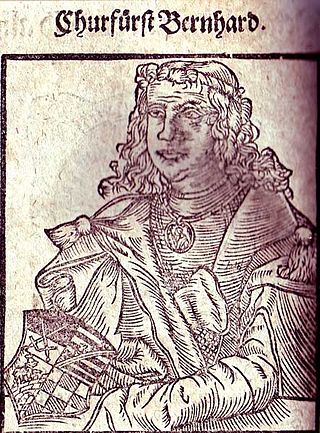Life
After the death of his father in 1304, Otto inherited his principality of Anhalt-Aschersleben.
Otto participated in the political feuds typical of his era. In 1307 he supported the House of Wettin. After years of maintaining close ties with his cousin Waldemar, Margrave of Brandenburg-Stendal, Otto broke with him and became a vassal of King Eric VI of Denmark in 1315. He died shortly after; the last male of his family, the line of Anhalt-Aschersleben became extinct upon his death.
The Bishopric of Halberstadt took over his principality and lands (including Aschersleben) as payment for debt after his death. The presiding Anhalt prince at this time, Bernhard II of Anhalt-Bernburg, recognized the validity of the bishop's claim to this territory and the transfer was agreed upon in a contract signed in December 1316. The rights to the Principality of Anhalt-Aschersleben were disputed and argued over for centuries. In 1648, the prince/electors of Brandenburg took over the Bishopric of Halberstadt and all its possessions, including all of the land and rights once possessed by Prince Otto II.
The House of Ascania was a dynasty of German rulers. It is also known as the House of Anhalt, which refers to its longest-held possession, Anhalt.

The history of Saxony-Anhalt began with Old Saxony, which was conquered by Charlemagne in 804 and transformed into the Duchy of Saxony within the Carolingian Empire. Saxony went on to become one of the so-called stem duchies of the German Kingdom and subsequently the Holy Roman Empire which formed out of the eastern partition of the Carolingian Empire. The duchy grew to become a powerful state within the empire, ruling over much of what is now northern Germany, but following conflicts with the emperor it was partitioned into numerous minor states, including the Principality of Anhalt, around the end of the 12th century and early 13th century. The territories of the Duchy of Saxony, the Principality of Anhalt, and their successors are now part of the modern German state of Saxony-Anhalt.

The Archbishopric of Magdeburg was a Latin Catholic archdiocese (969–1552) and Prince-Archbishopric (1180–1680) of the Holy Roman Empire centered on the city of Magdeburg on the Elbe River.

Anhalt-Bernburg was a principality of the Holy Roman Empire and a duchy of the German Confederation ruled by the House of Ascania with its residence at Bernburg in present-day Saxony-Anhalt. It emerged as a subdivision from the Principality of Anhalt from 1252 until 1468, when it fell to the Ascanian principality of Anhalt-Dessau. Recreated in 1603, Anhalt-Bernburg finally merged into the re-unified Duchy of Anhalt upon the extinction of the line in 1863.

Henry III, called Henry the Illustrious from the House of Wettin was Margrave of Meissen and last Margrave of Lusatia from 1221 until his death; from 1242 also Landgrave of Thuringia.
Magnus I (1304–1369), called the Pious, was duke of Brunswick-Lüneburg.

The Diocese of Halberstadt was a Roman Catholic diocese from 804 until 1648. From 1180, the bishops or administrators of Halberstadt ruled a state within the Holy Roman Empire, the prince-bishopric of Halberstadt. The diocesan seat and secular capital was Halberstadt in present-day Saxony-Anhalt.

Falkenstein/Harz is a town in the Harz district, in Saxony-Anhalt, Germany. It was created in 2002 by merging the town of Ermsleben with the former municipalities of Endorf, Meisdorf, Neuplatendorf, Pansfelde, Reinstedt und Wieserode. The new community was named after Falkenstein Castle.

Anhalt-Aschersleben was a short-lived principality of the Holy Roman Empire ruled by the House of Ascania with its residence at Aschersleben in present-day Saxony-Anhalt. It emerged as a subdivision from the Principality of Anhalt from 1252 to 1315.

The Principality of Anhalt was a State of the Holy Roman Empire, located in Central Germany, in what is today part of the federal state of Saxony-Anhalt.

Brandenburg-Schwedt was a secundogeniture of the Hohenzollern margraves of Brandenburg, established by Prince Philip William who took his residence at Schwedt Castle in 1689. By appanage, they administered the manors of Schwedt and Vierraden on the Oder river as well as Wildenbruch in Pomerania. Though prosperous, the cadet branch never obtained Imperial immediacy.

Bernhard, a member of the House of Ascania, was Count of Anhalt and Ballenstedt, and Lord of Bernburg through his paternal inheritance. From 1180 he was also Duke of Saxony.

Henry I, a member of the House of Ascania, was Count of Anhalt from 1212 and the first ruling Anhalt prince from 1218 until his death.

Henry II, Prince of Anhalt-Aschersleben was a German prince of the House of Ascania and ruler of the principality of Anhalt-Aschersleben.

Otto I, Prince of Anhalt-Aschersleben was a German prince of the House of Ascania and ruler of the principality of Anhalt-Aschersleben.

Bernhard II, Prince of Anhalt-Bernburg, was a German prince of the House of Ascania and ruler of the principality of Anhalt-Bernburg.
George I, Prince of Anhalt-Dessau, was a German prince of the House of Ascania and ruler of the principality of Anhalt-Dessau. He was the second son of Sigismund I, Prince of Anhalt-Dessau, by his wife Judith, daughter of Gebhard XI, Count of Querfurt.

Matilda of Brandenburg, a member of the House of Ascania, was first Duchess consort of Brunswick-Lüneburg from 1235 to 1252 by her marriage with the Welf duke Otto the Child.
Albert II of Brunswick-Lüneburg, a member of the House of Welf, was Prince-Bishop of Halberstadt from 1325 until his death. His regnal numbers indicate that he was the second Bishop Albert of Halberstadt. His reign can be characterized as an almost unbroken series of conflicts with the Pope, his cathedral chapter, the city of Halberstadt and various neighbouring Lords and Princes.















